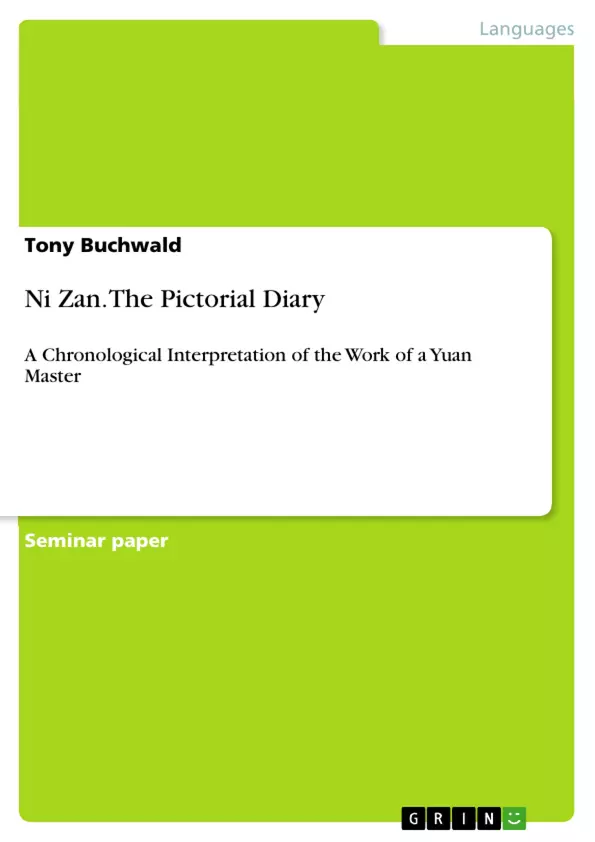Ni Zan is one of the most famous figures in the history of Chinese painting and together with the
other three of the „Four Great Masters of the Late Yuan“ – Huang Gongwang, Wang Meng and
Wu Zhen – formed the favored model for later landscapists. His influence on and appreciation in
later times as well as his position among his contemporaries have been discussed on various
occasions and should not be my main topic. My focus is on Ni Zan himself.
Following the fall of the Song Dynasty to the Mongols under Kublai Khan in 1271, the Yuan
Dynasty was established. That year marked the beginning of a period of turmoil and suppression
all over China, but especially for the Chinese intelligentsia and the Yuan dynasty, although
comparatively short, caused massive changes in cultural creativity, bringing forth painting styles
that would persist and be quoted in the art scene of all later centuries.
Taking a look at Ni Zan's paintings one cannot but notice certain elements that keep on appearing
throughout all of his oevre. Once he settled on a certain compositional type he kept repeating it. At
closer inspection one can see his painting style slightly changing, although keeping to some fixed
elements. This change in Ni's work is subtle, but noticeable and also readable. The readability of his
landscapes is the basis for this paper and will become clearer when going through Ni Zan's life,
along with the events surrounding his time and simultaneously reading his paintings as the Chinese
term du hua (to read painting) suggests. That way I will show how Ni Zan's paintings can be seen as
a journal and thereby now provide us with room for interpretation and insight into his life.
I should note that the main inspiration for this paper came from Maxwell K. Hearn, a curator at the
Metropolitan Museum of Art, and I therefore quote the term he used for this phenomenon by titling
this paper The Pictorial Diary.
Inhaltsverzeichnis (Table of Contents)
- Remarks on the Form
- Introduction
- Historical Background
- Biographical Background
- On the Style of Ni Zan's Painting
- Chronological Interpretation of Ni Zan's Work - The Pictorial Diary
- Conclusion
- Glossary of Chinese Names and Terms
- Bibliography
- List of Figures
- Figures
- Picture Credits
Zielsetzung und Themenschwerpunkte (Objectives and Key Themes)
This paper aims to explore the life and art of Ni Zan, a renowned figure in Chinese painting. It examines the historical and biographical context surrounding his work, with a particular focus on the Yuan Dynasty, a period of transition and cultural change in China. By analyzing the stylistic elements and themes present in his paintings, the paper seeks to understand how Ni Zan's art can be interpreted as a reflection of his personal experiences and the sociopolitical realities of his time.
- The impact of the Yuan Dynasty on Chinese culture and art.
- The development of Ni Zan's unique painting style and its significance.
- The role of artistic expression as a form of personal commentary and social critique.
- The interpretation of Ni Zan's paintings as a "Pictorial Diary" reflecting his life and experiences.
- The importance of understanding Chinese painting in its historical and cultural context.
Zusammenfassung der Kapitel (Chapter Summaries)
The introduction provides an overview of Ni Zan's importance within the history of Chinese painting, highlighting the influence of the "Four Great Masters of the Late Yuan." It also introduces the concept of the "Pictorial Diary," which is the central theme of this paper.
Chapter 2 delves into the historical context of the Yuan Dynasty, focusing on its impact on Chinese scholars and intellectuals. It examines the challenges faced by the literati class under Mongol rule and the subsequent rise of seclusion and artistic expression as alternatives to official service.
- Arbeit zitieren
- Tony Buchwald (Autor:in), 2011, Ni Zan. The Pictorial Diary, München, GRIN Verlag, https://www.hausarbeiten.de/document/274500


